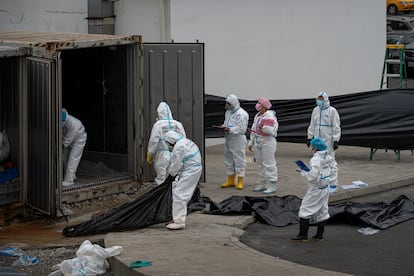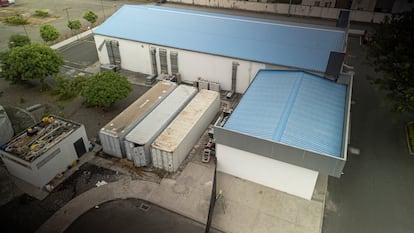A morgue in Ecuador struggles with over 200 rotting corpses of murder victims
Unidentified bodies have been stacked in a single container after the rest broke down in the violence-plagued city of Guayaquil


More than 200 rotting corpses of murder victims, many of them unidentified and others unclaimed by anyone, have collapsed the morgue in the city of Guayaquil, the economic engine of Ecuador. Three different sources confirmed this to EL PAÍS, which also collected photographic evidence of the authorities’ attempt to remedy this crisis. The smell of death has flooded the surroundings of the Forensic Medicine facilities in Guayaquil, the city of Ecuador with the highest number of homicides. Six months ago, one of the containers that housed these bodies stopped working and they were moved to the only one that was still operational. Now, this space has become overloaded and the corpses no longer fit. The liquids produced by decay have begun to seep through the cracks.
At the door of the container, officials have been collecting body parts that came out of their forensic covers, and stored them in bags. They have used light towers to illuminate the back of the container, where human arms, heads and loose torsos were piled up. Family members have been suffering from this institutional inability to care for the corpses of their loved ones. Daniel has been asking for months for the body of his cruelly murdered daughter to be returned to him. Her body came in for an autopsy and has not yet come out. “They don’t see our pain, we won’t even be able to hold a wake over her body, because it has been here for too long,” says the father. Officials give other relatives excuses not to hand over the bodies: “They are not ready yet,” “Come back tomorrow.” And when they get tired of lying, they tell them the truth: “The corpse is lost.” Where was it lost? The bodies are lost in the same place where the State keeps them, where evidence is sought to identify the cause of death.

So far this year, more than 1,300 crimes have been reported in Guayaquil, but corpses from many more places reach these laboratories. It is here that the bodies of people who were shot, asphyxiated and mutilated in the nearby locations of Durán, Posorja, Playas, Tenguel, Samborondón and Daule are brought for examination. When the medical examiner finishes the autopsy, the bodies are stored in individual niches inside a cold room with a capacity for 15 corpses, where they remain until a relative comes to claim them. However, prison massacres have led to an accumulation of charred human body parts that have yet to be identified. And instead of storing one corpse, two or even three bodies are squeezed into each niche.
The bodies have continued to pile up with the surge in violence. In some cases, the advanced state of decay makes it impossible to obtain fingerprints, which means that to determine their identity, experts require a genetic profile and a family member to compare it to. But many bodies are not claimed by anyone and end up being classified as NN (unidentified). These corpses began to fill two containers measuring 12 meters in length each, the same ones that were provisionally used to preserve the bodies of Covid-19 victims in the first months of the pandemic. Six months ago, however, one of these containers was damaged. According to the sources consulted for this story, there are around 200 bodies rotting in the only container still available.
The Legal Medicine and Forensic Sciences Service, responsible for the administration of the morgues, alluded to the crisis through a statement in which it said that on June 8, one of the damaged refrigerated containers went back into operation. But the bodies have not yet been transferred there because the staff has not been given the necessary biosafety equipment to avoid diseases resulting from decay, which makes it impossible for them to enter the container, despite the desperation of the authorities to resolve the crisis.

Despite the figures displayed by the government to prove that violence has been reduced, the National Legal Medicine Service recognizes that due to the increase in criminal violence in the country, there is now a greater number of NN corpses. That is, bodies that have not been identified or claimed by their relatives. The number of forensic doctors has not increased despite the high demand for autopsies. The bodies arrive by the dozens every day at the forensic center, where only four employees carry out all the work. They must handle more than 15 corpses in an eight-hour shift, when the protocol estimates that the examination procedure, which includes taking photographs and samples, can take between three and six hours for each body. Now, this procedure does not take more than 30 minutes.
The situation at the morgue is critical, according to testimonies. The evidence that could be collected from the corpses is lost due to the urgency with which autopsies are performed. There are cases of shooting victims in which, by the time they reach the doctors’ table, it is no longer possible to determine which is the bullet entry or exit hole because the maggots have eaten the edges of the holes made by the projectiles. The most difficult thing to determine is whether a person was killed by strangulation or whether it was a suicide by hanging, since the marks wear off when the body begins to decompose.
Amid all the bullet-ridden and stabbed corpses, there are also the bodies of women who were victims of femicide. In a fresh body, nail swabs can be taken to collect cells that might allow experts to identify the alleged aggressor, but if the body arrives in a state of decay, the nails fall off. Nor can samples of vaginal fluid be taken in the case of rape, which is an aggravating factor in the event of a court conviction against the aggressor. The government, however, assures that femicides have also decreased by 17%.
Late on Wednesday afternoon, the Forensic Medicine Service set up an operation to remove the bodies from the container. At this time the staff did have biosafety protective gear. Two and up to three people moved the black bags from the collapsed container to transfer it to the newly enabled one. The morgue crisis, however, remains intact.
Sign up for our weekly newsletter to get more English-language news coverage from EL PAÍS USA Edition
Tu suscripción se está usando en otro dispositivo
¿Quieres añadir otro usuario a tu suscripción?
Si continúas leyendo en este dispositivo, no se podrá leer en el otro.
FlechaTu suscripción se está usando en otro dispositivo y solo puedes acceder a EL PAÍS desde un dispositivo a la vez.
Si quieres compartir tu cuenta, cambia tu suscripción a la modalidad Premium, así podrás añadir otro usuario. Cada uno accederá con su propia cuenta de email, lo que os permitirá personalizar vuestra experiencia en EL PAÍS.
¿Tienes una suscripción de empresa? Accede aquí para contratar más cuentas.
En el caso de no saber quién está usando tu cuenta, te recomendamos cambiar tu contraseña aquí.
Si decides continuar compartiendo tu cuenta, este mensaje se mostrará en tu dispositivo y en el de la otra persona que está usando tu cuenta de forma indefinida, afectando a tu experiencia de lectura. Puedes consultar aquí los términos y condiciones de la suscripción digital.
More information
Archived In
Últimas noticias
Most viewed
- Sinaloa Cartel war is taking its toll on Los Chapitos
- Reinhard Genzel, Nobel laureate in physics: ‘One-minute videos will never give you the truth’
- Oona Chaplin: ‘I told James Cameron that I was living in a treehouse and starting a permaculture project with a friend’
- Why the price of coffee has skyrocketed: from Brazilian plantations to specialty coffee houses
- David King, chemist: ‘There are scientists studying how to cool the planet; nobody should stop these experiments from happening’









































